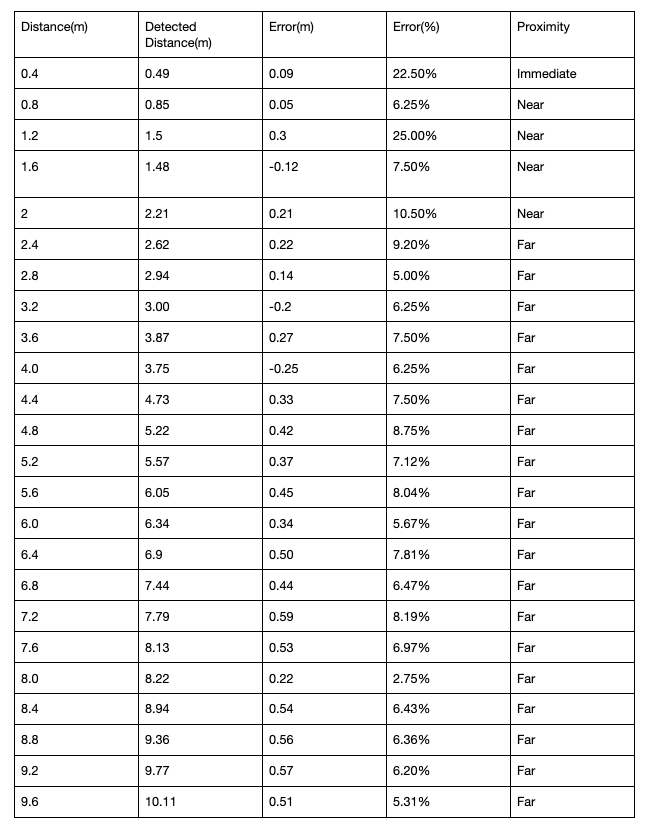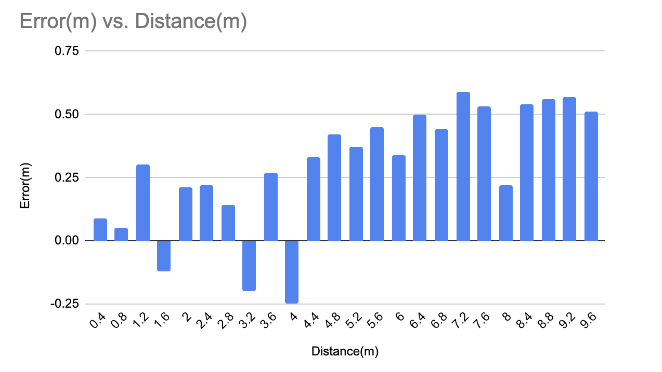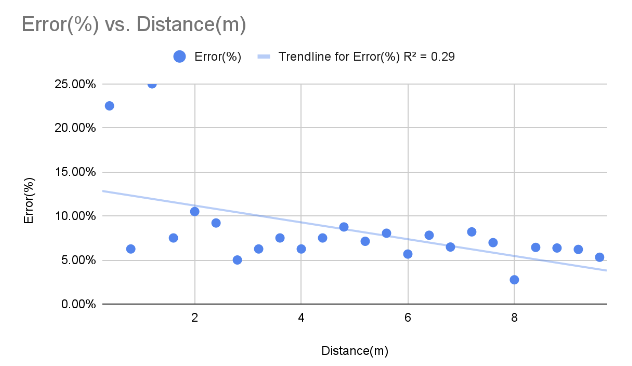Kevin Guo, Year 2 Engineering.
Abstract
Advancements in Bluetooth technology in recent years have introduced features beyond simple data transmission and have raised questions regarding its viability as a substitute for traditional location services technologies such as GPS and WiFi but past versions of Bluetooth have all proved to be too volatile and inconsistent to perform as a legitimate alternative. With the recent introduction of Bluetooth 5.0 hardware into smartphones, the question of whether the technology has finally caught up once again arises. We aim to answer this question by experimentally measuring the accuracy of BLE location tracking through creating a BLE based location tracking app and testing its accuracy. From this, we discovered an improvement in accuracy compared to previous versions but ultimately, BLE is still not yet a viable alternative.
Introduction
The applicability of location tracking services has increased in recent years across various industries (Dudhane and Pitambare, 2015). During the COVID 19 pandemic, location tracking was used for contact tracing and proved useful in warning individuals of potential exposures to the virus (“Download COVID Alert Today”). The foundational technology behind this task was Bluetooth Low Energy (BLE), a more battery-friendly version of Bluetooth (Proctor, 2021). An app was created using BLE which would detect the presence of nearby smartphone users and if one of the users were to test positive for COVID, the app would alert all other users (“Download COVID Alert Today”). The decision to use Bluetooth rather than traditional location tracking technologies such as WiFi or GPS bolsters the potential for Bluetooth to act as a locally hosted and more energy-efficient alternative (Putra et al., 2017). Previous studies have mainly been concerned with the accuracy (Park et al, 2015) and the limited range (Dudhane and Pitambare, 2015) of Bluetooth before ultimately coming to the conclusion of ineffectiveness. Park et. al’s paper aimed to create an algorithm to reduce the error but ultimately, during experimental testing, the location tracking still contained a discrepancy of 1.77m (Park et al, 2015). On the other hand, Dudhane and Pitambare’s paper, which aimed to discuss Bluetooth’s industrial applications, raised concerns over Bluetooth’s effective range of just a few meters, indicating that multiple roadblocks were present in obstructing its viability as a location tracking technology (Dudhane and Pitambare, 2015). However, these studies all tested older versions of Bluetooth but with the release of Bluetooth 5.0, which bolsters direction finding and improved location services (Sawers, 2019), Bluetooth once again appears to be a useful location tracking tool. In this experiment, we will build off of the concerns of previous studies by studying the accuracy of BLE tracking.
Materials and Methods
In order to determine the effectiveness of Bluetooth location tracking an app that used Bluetooth to determine the proximity and specific distance of a device was created and then tested. The coding language Swift was chosen because it is compatible with the IOS interface and has built-in Bluetooth and location detection APIs. The Xcode compiler and the Storyboard UI were used to create an app that would execute these features.
Two smartphones/tablets with Bluetooth functionality are required. One served as the “beacon” which transmits Bluetooth signal and the other served as the “beacon detector” which received the Bluetooth signal from the beacon and then analyzed it to determine proximity and distance.
Establishing a Connection
The first step was to establish a connection between the beacon and the beacon detector. To do so, the beacon was instructed to access the device’s Bluetooth functionality and then begin broadcasting a signal with a pre-determined Universal Unique Identifier (UIUD). The beacon detector would have been given this preset UIUD and looked for that device.
Determining Proximity
Using the built-in iBeacon API, the proximity of a beacon device can be found. The API has preexisting categories of “far,” “near,” and “immediate.” Using this built-in feature, the beacon detector is then instructed to acquire the proximity of the beacon. However, the categories do not have specific distances to differentiate them. Instead, they are simply meant to provide a relative distance from one device to the other. The beacon is an object class with a proximity variable so the proximity can be accessed by calling on that variable.
Determining Distance
To determine the exact distance the beacon is from the beacon detector, several different values are needed: the Received Signal Strength Indicator (RSSI), the measured power, and the environmental constant (N). Then, using equation 1, we can calculate the distance.

(1)
The RSSI is a built-in value of a Bluetooth signal and can be determined simply by using code to acquire the value from the beacon. The beacon is an object class that contains an RSSI variable so the value can be accessed by calling on that variable. The Measured Power is a fixed value set by the device manufacturer and is equal to the RSSI value when the beacon is 1 meter away from the beacon detector. The Measured Power for an iPhone, the device used in this case, is not available online and so the measured power was determined experimentally. The environmental constant depends on the specific devices being used so it must be determined experimentally as well. The beacon is placed 0.5m away from the beacon detector and using the RSSI value at that position, the environmental constant can be algebraically found.
Results
The objective of the beacon detector is to determine the distance away the beacon is from it. Therefore, the variability and error of the detection were tested at different distances. The final data showed that, in general, as the beacon got further away from the beacon detector, the percentage error decreased but the error in meters increased. Furthermore, the majority of the errors were overestimates with only a few underestimates at closer distances.
Table 1. Table displaying the actual distance, detected distance, error in meters, percentage error, and detected proximity.


Figure 1. Graph showing the error in meters for each distance tested.

Figure 2. Graph showing the percentage error for each distance tested.
Discussion
Ultimately, the beacon detector was unable to provide consistent accurate estimates for the approximate proximity of the beacon. However, for specific distances, the detector had an average percentage error of 8.31% and an actual error of 0.295m.
The higher percentage error for closer distances compared to further distances makes sense because, at low distances, variations cause larger relative deviations. Furthermore, as the beacon moves further away, the signal becomes more volatile and thus the actual deviation increase but because of the increased distance, the relative deviation decreases. However, the R^2 value for this trend is only 0.29, indicating that the relationship between distance and percentage error is not very strong.
One explanation for the relatively large error result is that RSSI values can only be shown as integers. As such, nuanced differences in RSSI values cannot be captured and will always be approximated. Furthermore, the hardware on the beacon and the beacon detector is not accurate enough as the RSSI value was extremely volatile and even when both the beacon and the beacon detector stayed still, it would sometimes jump significantly, creating a chance for error. As a result, the measured power and environmental constant, which were both determined experimentally, may not be accurate as the RSSI value could be different if the measurement was carried out again. Lastly, the testing environment had various objects such as desks in the way which could have caused interference. This would explain the volatility of the RSSI value.
However, the results of this experiment serves as a positive improvement from previous work. Compared to a similar experiment conducted in 2015 (Dudhane and Pitambare, 2015), which aimed to investigate the accuracy of BLE based indoor location tracking, the results of our experiment contained a far smaller margin of error. This development is in line with the proclaimed improvements in location accuracy from Bluetooth 4.2 (used in the 2015 experiment) and Bluetooth 5.0 (used in our experiment).
For future experiments, the environment of testing would need to be taken into account and ideally, the beacon should be tested in crowded and non-crowded areas. Furthermore, better hardware should be used to maintain a more consistent and accurate RSSI value. In order to truly uncover the applicability of BLE location tracking, studies must also be conducted in context of specific intended uses. For instance, work into the accuracy in crowded areas with high signal interference can be used to determine the viability of using BLE tracking on shoppers inside a store.
References
“Download COVID Alert Today.” Government of Canada, www.canada.ca/en/public-health/services/diseases/coronavirus-disease-covid-19/covid-alert.html. Accessed 10 Apr. 2022.
Dudhane, Nilima A., and Sanjeevkumar T. Pitambare. “Location Based and Contextual Services Using Bluetooth Beacons: New Way to Enhance Customer Experience.” Lecture Notes on Information Theory, vol. 3, no. 1, 2015, https://doi.org/10.18178/lnit.3.1.31-34. Accessed 10 Apr. 2022.
G. D. Putra, A. R. Pratama, A. Lazovik and M. Aiello, “Comparison of energy consumption in Wi-Fi and bluetooth communication in a Smart Building,” 2017 IEEE 7th Annual Computing and Communication Workshop and Conference (CCWC), 2017, pp. 1-6, doi: 10.1109/CCWC.2017.7868425.
Kingatua, Amos. “Bluetooth Indoor Positioning and Tracking Solutions.” Medium, 26 Mar. 2020, medium.com/supplyframe-hardware/bluetooth-indoor-positioning-and-asset-tracking-solutions 8c78cae0a03#:~:text=Bluetooth%20indoor%20positioning%20system%20(IPS,to%20their%20areas%20of%20interest. Accessed 27 Mar. 2022.
Park, Joonghong & Kim, Jaehoon & Kang, Sungwon. (2015). BLE-Based Accurate Indoor Location Tracking for Home and Office. Computer Science & Information Technology. 5. 173-181. 10.5121/csit.2015.51614.
Proctor, Bob. “Bluetooth Vs. Bluetooth Low Energy: What’s the Difference?” Link Labs, 19 Aug. 2021, www.link-labs.com/blog/bluetooth-vs-bluetooth-low-energy. Accessed 10 Apr. 2022.
Sawers, Paul. “Bluetooth gains ‘direction finding’ for location accuracy to the centimeter.” VentureBeat, 28 Jan. 2019, venturebeat.com/2019/01/28/bluetooth-gains-direction-finding-for-location-accuracy-to-the-centimeter/. Accessed 10 Apr. 2022.Shah, Rakshit. “Convert RSSI Value of the BLE (Bluetooth Low Energy) Beacons to Meters.” Medium, 30 June 2021, medium.com/beingcoders/convert-rssi-value-of-the-ble-bluetooth-low-energy-beacons-to-meters-63259f307283#:~:text=Distance%20%3D%2010%20%5E%20((Measured%20Power,RSSI)%2F(10%20*%20N)). Accessed 27 Mar. 2022.